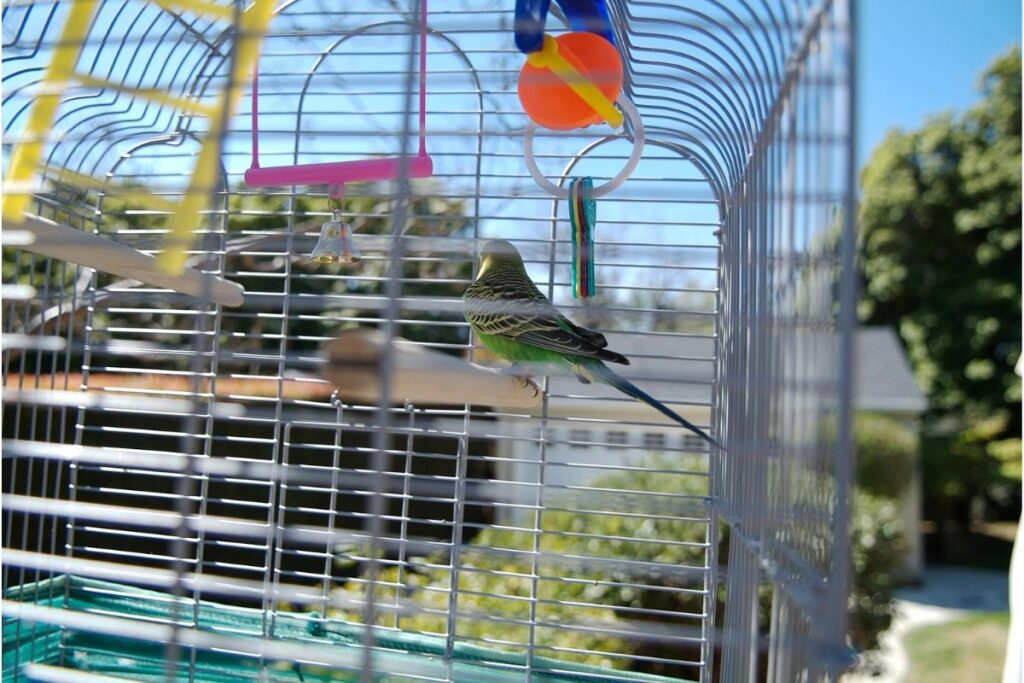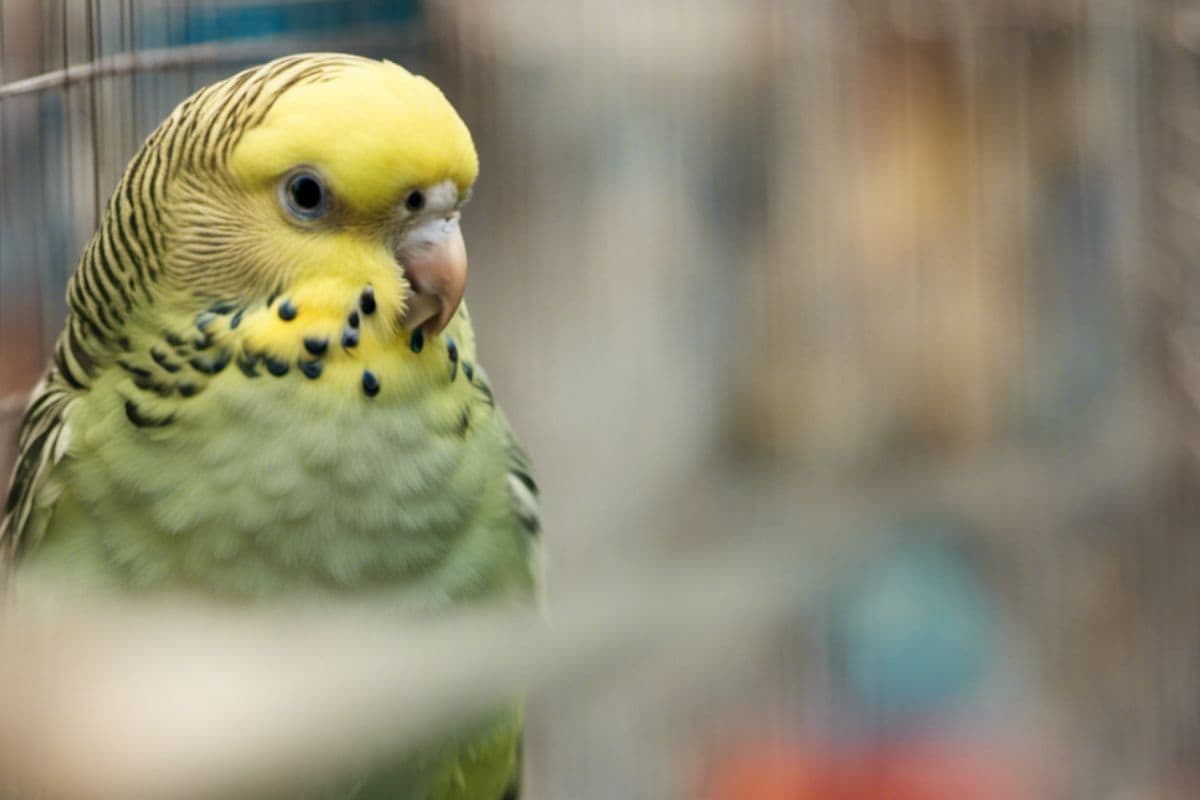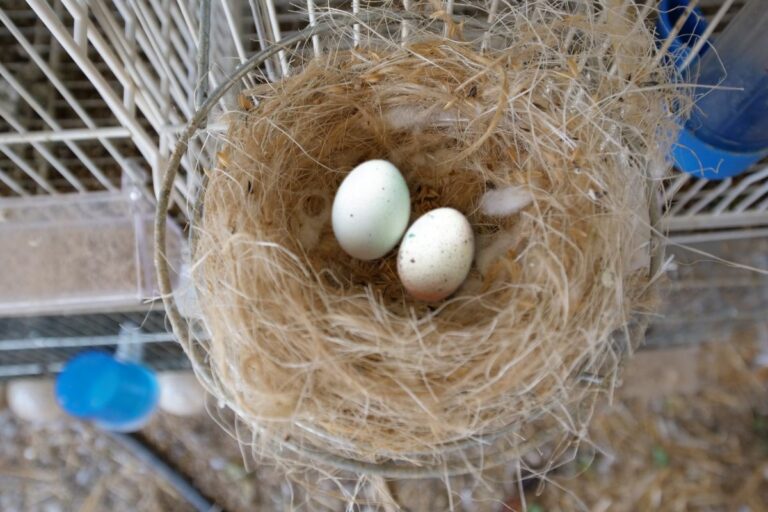How Do You Calm a Scared Parakeet
Disclosure: The opinions expressed in this post are my own. This post may also contain affiliate links, which means that I will receive a commission if you decide to purchase through my links, at no additional cost to you. As an Amazon Associate, I earn from qualifying purchases.
Are you a bird lover who has recently adopted a scared parakeet? If so, you may be wondering how to calm your feathered friend and help them feel safe in their new environment. Well, you’ve come to the right place! With a few simple techniques and a lot of patience, you can calm a scared parakeet and build a trusting relationship with them.
Parakeets are known for their skittish nature and can easily become frightened by new people, loud noises, or sudden movements. However, by understanding their behavior and providing a calm and secure environment, you can help your parakeet overcome their fears and become more comfortable in their surroundings.
In this article, we will explore various methods to calm a scared parakeet, including creating a safe space, using positive reinforcement, and establishing a routine.
So, whether you are a new parakeet owner or have had your bird for a while but are struggling with their fearfulness, keep reading to discover helpful tips and techniques that will make your parakeet feel safe and happy in their new home.
How to Calm Down a Scared Parakeet
Calm down a scared parakeet may seem like a challenging task, but with the right approach and patience, you can help your feathered friend feel safe and secure. Here are a few proven methods to calm down a scared parakeet:
1. Be Kind and Talk to Your Parakeet Softly
When trying to calm a scared parakeet, it is crucial to be kind and talk to them softly. Parakeets are sensitive creatures and respond well to gentle and soothing tones.
Speak to them in a soft and reassuring voice. Let them know that you are there for them and that they are safe. Avoid using any harsh or loud tones as this may only increase their anxiety.
You can also try using calming phrases or words that your parakeet is familiar with. For example, if you usually say “good morning” or “hello” to your parakeet, continue using those phrases to provide a sense of familiarity and comfort.
Additionally, it can be helpful to speak in a slightly higher pitch as parakeets are more attuned to higher frequencies. This can capture their attention and make them feel more at ease.
2. Give Your Parakeet Some Treats

One effective way to calm a scared parakeet is by giving it some treats. Treats can help to create a sense of comfort and security for your feathered friend.
When choosing treats for your parakeet, opt for healthy options that are specifically designed for birds. Avoid giving them sugary or fatty treats, as these can be harmful to their health. Instead, look for treats that are made with natural ingredients and provide essential nutrients.
To give your parakeet treats, start by observing its body language. If it seems tense or apprehensive, approach slowly and gently. Offer the treat by holding it between your fingers or placing it in a small dish near the bird. It’s important to be patient and allow the parakeet to approach the treat at its own pace. Avoid any sudden movements or loud noises that may startle the bird.
As the parakeet begins to associate treats with positive experiences, it will gradually become more comfortable and less scared. This process may take time, so it’s important to be consistent and offer treats regularly. Over time, your parakeet will learn to trust you and associate you with positive experiences.
3. Approach and Handle Your Parakeet Gently
Approaching and handling your scared parakeet gently is crucial to help calm them down and build trust. Here are three steps to follow:
- Move Slowly: When approaching your scared parakeet, make sure to move slowly and avoid sudden movements. Sudden movements can startle them and make them more scared. Instead, approach them calmly and with a relaxed body posture. This will help them feel more comfortable and less threatened.
- Offer a Hand, Palms Facing Up: Once you are close to your parakeet, extend your hand towards them, palm facing up. This gesture shows that you are not a threat and allows them to become familiar with your hand. Allow them to approach your hand at their own pace, without forcing them.
- Practice Gentle Handling: Once your parakeet is comfortable with your hand, you can start gently handling them. Use a soft touch and avoid grabbing or squeezing them. Instead, let them perch on your finger or hand. This will help them feel secure and safe. If they show signs of discomfort or try to fly away, slowly and gently release them to avoid causing further stress.
Remember, building trust with a scared parakeet takes time and patience. It’s essential to respect their boundaries and never force them into any interaction. With consistent gentle handling, your parakeet will gradually become more comfortable and trusting in your presence.
4. Create a Calm Environment

Creating a calm environment is crucial when trying to calm a scared parakeet. These small birds can easily become overwhelmed and stressed, so it’s important to provide them with a peaceful and secure space. Here are four steps to create a calm environment for your scared parakeet:
- Choose a Quiet Location: Find a quiet area in your home where your parakeet can feel safe and undisturbed. Avoid placing their cage in high traffic areas or near noisy appliances such as televisions or washing machines. A peaceful corner or a room with minimal activity is ideal.
- Provide a Cozy Hiding Spot: Parakeets often feel more secure when they have a hiding spot to retreat to. Place a small, enclosed space inside their cage, such as a birdhouse or a covered perch. This will give them a sense of security and a place to escape to when they feel scared or anxious.
- Control the Lighting: Lighting plays a significant role in creating a calm environment for parakeets. Avoid harsh and bright lights that can startle or stress them out. Instead, opt for soft, diffused lighting that mimics their natural habitat. Use curtains or blinds to regulate the amount of natural light entering the room.
- Play Calming Sounds: Just like humans, parakeets can find soothing sounds relaxing. Play soft, gentle music or nature sounds in the background to create a serene atmosphere. Avoid sudden loud noises or jarring sounds that can startle your parakeet and undo all your efforts to create a calm environment.
By following these steps and creating a calm environment, you can help your scared parakeet feel more at ease and gradually overcome their fears.
5. Play & Interact With Your Parakeet

Playing and interacting with your scared parakeet is an essential step in calming them down and building a trusting relationship. Here are three of our favorite ways you can try to effectively engage with your feathered friend:
- Practice Step-Up Training: Teach your parakeet the “step-up” command, which involves getting them to step onto your finger or a perch. Start by placing your finger near their feet and gently applying pressure. Once they step onto your finger, reward them with praise and a treat. Gradually increase the duration of the step-up and make it a regular part of your interaction routine.
- Engage in iInteractive Games: Parakeets love games that involve movement and interaction. You can play “fetch” with a small ball or paper ball, gently rolling it towards them and encouraging them to push it back to you. You can also use a feather wand to stimulate their natural hunting instincts.
- Talk and Sing to Your Parakeet: Parakeets are highly social birds and enjoy the sound of human voices. Spend time talking, singing, or reading to your parakeet. This will not only help them get used to your presence but also provide a soothing and calming effect.
6. Provide Your Parakeet Toys to Play With

One way to calm a scared parakeet is by providing them with toys to play with. Parakeets are intelligent and curious birds, and having toys in their cage can help keep them entertained and distracted from their fears.
When choosing toys for your parakeet, it’s important to consider their safety. Look for toys that are specifically designed for birds and made from non-toxic materials. Avoid toys with small parts that can be easily swallowed or cause injury.
There are various types of toys that you can provide for your parakeet. Interactive toys, such as puzzle toys or treat-dispensing toys, can stimulate their mind and provide a fun challenge. Swinging toys or hanging toys can also be great for parakeets, as they love to climb and swing.
Toys that make noise, such as bells or rattles, can be entertaining for your parakeet. They enjoy the sound and may even try to mimic it.
Rotating the toys in your parakeet’s cage regularly can help keep them engaged. Introducing new toys or rearranging their placement can provide novelty and prevent boredom. It’s important to observe your parakeet’s preferences and remove any toys that they show no interest in or that may be causing them stress.
Remember that while toys can provide mental stimulation and entertainment, they are not a substitute for social interaction and companionship. Spending time with your parakeet outside of their cage, talking to them, and offering gentle interactions can help build trust and alleviate their fears.
7. Establish a Routine
Establishing a routine is crucial when it comes to calming a scared parakeet. Parakeets, like many other pets, thrive on consistency and predictability. By establishing a routine, you can create a safe and secure environment for your feathered friend, helping them feel more at ease and reducing their fear and anxiety.
- Set a Schedule: Create a daily schedule for your parakeet that includes regular feeding times, playtime, and interaction. Stick to this schedule as closely as possible, as it will help your parakeet feel more comfortable and confident in their surroundings.
- Daily Exercise: Provide your parakeet with ample opportunities for exercise outside of their cage. Set up a safe and bird-proofed area where they can fly and explore. Regular exercise helps to reduce stress and promotes a sense of well-being.
- Playtime: Incorporate interactive toys and playtime into your parakeet’s routine. This not only provides mental stimulation but also helps them build confidence and trust. Offer a variety of toys that encourage natural behaviors, such as climbing, swinging, and foraging.
- Bedtime Routine: Establish a consistent bedtime routine for your parakeet. Cover their cage with a light, breathable fabric to create a dark and quiet sleeping environment. This routine will help them feel secure and promote a good night’s sleep.
Remember, every parakeet is unique, and it may take time and patience to establish a routine that works best for your feathered friend. By providing a stable and predictable environment, you can help calm their fears and create a bond built on trust and security.
8. Practice Positive Reinforcement: Reward Your Parakeet Whenever They Display Calm Behavior
Positive reinforcement is a powerful tool when it comes to calming a scared parakeet. By rewarding your parakeet whenever they display calm behavior, you can help them associate those actions with positive experiences and gradually reduce their fear and anxiety.
To practice positive reinforcement, you’ll need to identify specific calm behaviors that you want to encourage in your parakeet. This could include things like sitting quietly on a perch, staying relaxed when you approach their cage, or not flapping their wings excessively.
When you observe your parakeet displaying one of these calm behaviors, immediately offer them a reward. This can be a small treat, such as a piece of millet or a favorite seed. It’s important to reward them right away so they can make the connection between their behavior and the reward.
As you consistently reward your parakeet for calm behavior, they will start to understand that being calm leads to positive outcomes. This can help them feel more secure and confident in their environment.
9. Introduce a Companion

Introducing a companion to a scared parakeet can be an effective way to help calm their fears and provide them with a sense of comfort and security. Parakeets are social birds and often thrive in the company of other birds.
However, it’s important to remember that not all parakeets will readily accept a new bird, and in some cases, they may prefer to be the sole bird in the household. Always prioritize the well-being and happiness of your parakeet when making decisions about their socialization and companionship.
It’s also important to note that introducing a companion should be done in a careful way in order to reduce stress and prevent any potential conflict between the birds. Introduce them slowly and in a controlled environment, and be sure to monitor their behavior for any signs of aggression or fear. Read more on how to introduce a companion to a parakeet here.
How to Tell If My Parakeet is Scared?
It’s important to be able to tell if your parakeet is scared so that you can take the necessary steps to calm them down. Here are a few signs that your parakeet may be scared:
1. Fluffed Feathers

When a parakeet fluffs up their feathers, it’s a sign that they are trying to make themselves look bigger and more intimidating. If you notice your parakeet’s feathers are constantly fluffed, it may be a sign that they are feeling scared or threatened.
2. Hiding or Crouching
If your parakeet is constantly hiding in their cage or crouching in a corner, it’s a clear indicator that they are feeling scared. They may be trying to find a safe place where they can feel protected from potential threats.
3. Rapid Breathing
When a parakeet is scared, their heart rate increases and they may start to breathe rapidly. If you notice that your parakeet is breathing heavily or panting, it’s a sign that they are feeling anxious or frightened.
4. Aggressive Behavior
While some parakeets may cower or hide when they are scared, others may exhibit aggressive behavior as a defense mechanism. If your parakeet starts biting, hissing, or flapping their wings aggressively, it’s a sign that they are feeling threatened and trying to protect themselves.
5. Loss of Appetite
When a parakeet is scared, they may lose their appetite and refuse to eat. If you notice that your parakeet is not eating or drinking as usual, it may be a sign that they are feeling stressed or scared.
6. Feather Picking

Feather picking is a common behavior among scared parakeets. When a parakeet is feeling frightened, they may engage in self-plucking or feather picking as a way to cope with the stress. Feather picking can cause severe damage to the bird’s feathers and skin, making them more vulnerable to illnesses and injury.
7. Vocalizations
Parakeets may start to vocalize more frequently when they are feeling scared or stressed. This can include loud chirping, whistling, and even screaming if their fear reaches a high level. Monitor your parakeet’s vocalizations to help you recognize if they are feeling scared or anxious.
Reasons Why Parakeets Get Scared or Experience Stress
There are several reasons why parakeets may get scared or experience stress. Understanding these reasons can help you effectively calm your scared parakeet and create a comfortable environment for them.
1. Loud Noises

Parakeets have sensitive hearing, and sudden loud noises can startle them. Common sources of loud noises include vacuum cleaners, door slams, or even loud music. Try to minimize these noises or create a quiet, calm space for your parakeet.
2. Sudden Movements
Parakeets have a natural fear of sudden movements, as it can mimic the movements of predators. Avoid making quick or jerky movements around your parakeet, as this can scare them. Instead, move slowly and calmly when interacting with them.
3. Lack of Socialization
Parakeets are social creatures and can become stressed if they do not receive enough social interaction. Loneliness can make them anxious and fearful. Spend quality time with your parakeet, talk to them, and provide toys or companionship to alleviate their stress.
4. Changes in Environment

Parakeets are creatures of habit and can become stressed when their environment changes suddenly. This includes changes in cage placement, new objects or people in the surroundings, or even rearranging furniture. If you need to make changes, do so gradually to help your parakeet adjust.
5. Illness or Pain
Just like humans, parakeets can experience stress or fear when they are unwell or in pain. If your parakeet is displaying unusual behavior, such as fluffed feathers, loss of appetite, or excessive vocalization, it’s important to consult a veterinarian to rule out any health issues.
6. Lack of Routine
Parakeets thrive on routine and can become stressed if their daily routine is disrupted. Try to establish a consistent schedule for feeding, playtime, and sleep to create a sense of security for your parakeet.
By understanding the reasons why parakeets get scared or experience stress, you can take appropriate measures to provide a calm and safe environment for your feathered friend. Patience, consistency, and gentle handling will go a long way in helping your parakeet overcome their fears and become a happy, contented pet.
Why is My Parakeet Scared of Me?
Parakeets are known for their playful and social nature, but sometimes they can become scared or fearful of their owners. This can be concerning for bird owners, as they want to establish a bond of trust and companionship with their feathered friend. Understanding why your parakeet is scared of you is the first step in helping them overcome their fear.
- One possible reason for your parakeet’s fear could be a lack of socialization. If your parakeet was not properly socialized during its early stages of life, it may not be accustomed to human interaction and can perceive you as a threat.
- Another reason for your parakeet’s fear could be a negative past experience. If your parakeet had a traumatic encounter with humans, such as being mishandled or frightened, it may develop a fear response towards humans in general.
- Additionally, parakeets are prey animals by nature and have a natural instinct to be cautious and alert. They may perceive your size and movements as threatening, especially if you approach them too quickly or invade their personal space.
It is important to note that each parakeet is unique and may have different triggers for fear. Observing their body language and understanding their individual preferences can help you identify potential causes of fear and tailor your approach accordingly. Patience, consistency, and positive reinforcement are key when working with a scared parakeet.
Final Words
Calming a scared parakeet requires patience, understanding, and a gentle approach. Remember, each bird is unique and may respond differently to various techniques. It’s essential to create a safe and comfortable environment for your feathered friend, providing them with plenty of love and attention.
By following the steps outlined in this article, you can help your parakeet overcome their fear and develop a trusting bond with you. Remember to be consistent and persistent in your efforts, as it may take time for your parakeet to fully adjust.
Lastly, always consult with an avian veterinarian if you notice any concerning behaviors or if your parakeet’s fear persists. They can provide additional guidance and ensure the overall well-being of your beloved pet.
In the end, with love, patience, and a calm demeanor, you can help your scared parakeet feel safe and secure in their home. Enjoy the journey of building a strong and trusting relationship with your feathered companion!









